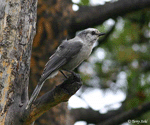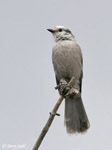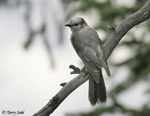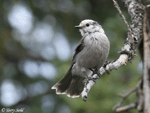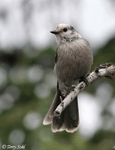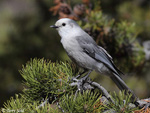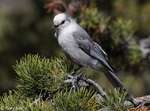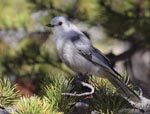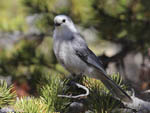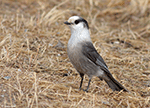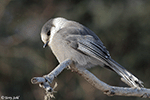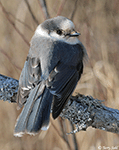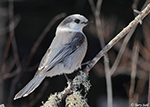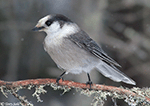| Length: 11.5 inches | Wingspan: 17 inches | Seasonality: All Seasons |
| ID Keys: Gray overall, with short black bill and black patch on back of head | ||
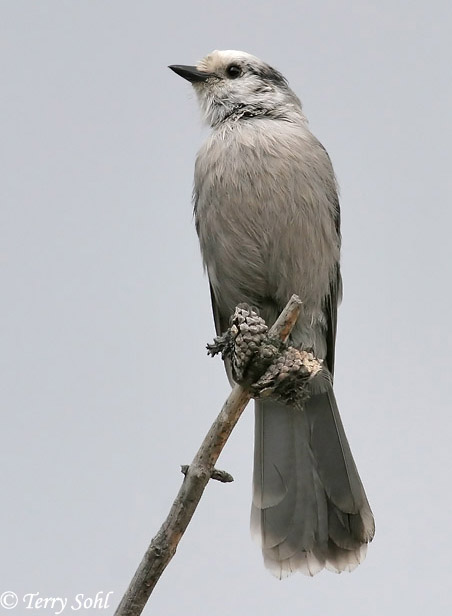 A bold resident of the west and north, Canada Jays (formerly known as Gray Jay) are often seen
stealing food items from unwary hikers and campers, a habit that has earned them
a nick name of the "Camp Robber". Well adapted to the cold climates in
which they are normally found, Canada Jays will stash food items in crevices of
bark, and retrieve the food items during harsher times. This habit and
resultant availability of food allows them to breed much earlier than other
species, with nesting occurring as early as the late winter. Canada Jays have several
races which differ most notably on the size of the black patch on the back of
their heads.
A bold resident of the west and north, Canada Jays (formerly known as Gray Jay) are often seen
stealing food items from unwary hikers and campers, a habit that has earned them
a nick name of the "Camp Robber". Well adapted to the cold climates in
which they are normally found, Canada Jays will stash food items in crevices of
bark, and retrieve the food items during harsher times. This habit and
resultant availability of food allows them to breed much earlier than other
species, with nesting occurring as early as the late winter. Canada Jays have several
races which differ most notably on the size of the black patch on the back of
their heads.
Habitat:
Canada Jays show a very strong preference for spruce trees, generally being found in spruce or mixed forests.
Diet:
Omnivorous, feeding on insects, birds eggs and young, small rodents, fruits, berries, seeds, nuts, carrion, and human refuse.
Behavior:
Very opportunistic, taking food in a wide variety of manners as opportunities present themselves. Depending upon the location and food item that's available, Canada Jays have been observed capturing flying insects in flight (flycatching), clambering through the foliage and branches of a tree and gleaning insects, or even wading in shallow water like a shorebird. They will store food to use during harsh winter months, using a special gland that produces a sticky saliva to "glue" food items in cached locations under tree bark or other protecting areas, returning to feed when times get tough.
Nesting:
March through May. Canada Jays are often breed very early in the season, and may begin nesting even prior to these dates if conditions are favorable. The nest is a cup of twigs, bark, mosses, and lichens, lined with softer materials. The female lays 3 or 4 eggs, and she alone incubates the eggs. When the eggs hatch, the female typically stays with the young at the start, while the male brings food. After several days, both parents bring food. The young leave the nest after about 3 weeks.
Song:
Wide variety of vocalizations, from soft whistles, to rougher and harsher notes.
- Click here for a calling Canada Jay1
- Click here for harsher, squawking calls of a Canada Jay2
- Click here for a "whisper call" of a Canada Jay3
Migration:
Generally a permanent resident. Some birds that summer at higher elevations may move to lower elevations for the winter.
Interactive eBird Map:
Click here to access an interactive eBird map of Canada Jay sightings
Similar Species:
Generally distinctive if seen well. Potentially confused with Clark's Nutcracker at distance or in poor light, as both are comparable in size, gray overall, with darker wings. However, Clark's Nutcracker have a much longer bill, and wings that are black as opposed to darker grey on a Canada Jay. In flight, Clark's Nutcracker also have extensive white outer tail feathers, and a white trailing edge on the wing, both of which are lacking on a Canada Jay in flight.
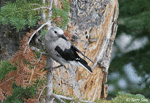 |
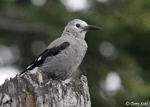 |
| Clark's Nutcracker | Clark's Nutcracker |
Conservation Status:
There may be some local declines in areas of habitat loss, as systematic surveys in recent years are showing a substantial decline in parts of their range. However, they are still found over a broad geographic area and are relatively common in parts of that range. The IUCN lists the Canada Jay as a species of "Least Concern".
South Dakota "Hotspot":
Literally all sightings of Canada Jays that have been reported in eBird in South Dakota are from the Black Hills area. There, sightings are spread across much of the Hills, but there are some areas where many sightings have been clustered over the years, including the Sylvan Lake Area, the area near Pactola Reservoir, or in and around Hanna Campground. Note that each of these are areas where camping, picnicking, and substantial human activity occur, and thus, there are potential opportunities for the Camp Robber to get an easy meal.
Feeders:
Canada Jays are opportunists, eating an incredibly wide array of food items. As such, they may be attracted to many items offered at feeders, but their favorite items may be peanut butter and suet. They will also readily consume various seed offerings at feeder complexes.
Further Information:
Photo Information:
August 9th, 2007 - Yellowstone National Park, Wyoming - Terry Sohl
Additional Photos:
Click on the image chips or text links below for additional, higher-resolution Canada Jay photos.
Audio File Credits:
- 1Davyd Betchkal. Recorded in Sanctuary River area of Alaska, on May 6th, 2012. Original recording and information available from xeno-canto.
- 2Tayler Brooks. Recorded in Coos County, New Hampshire on May 29th, 2010. Original recording and information available from xeno-canto.
- 3Andrew Spencer. Recorded in Humboldt County, California on January 16th, 2009. Original recording and information available from xeno-canto.
| Click on the map below for a higher-resolution view |
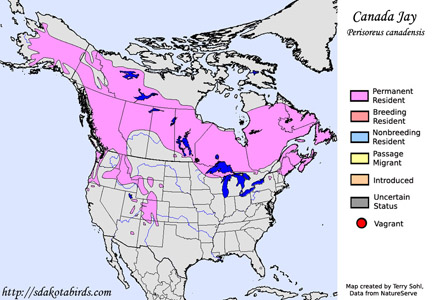 |
| South Dakota Status: Uncommon permanent resident in the Black Hills |
Additional Canada Jay Photos
Click for a higher-resolution version of these photos
